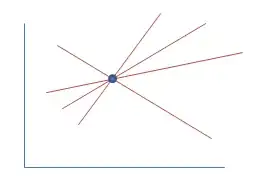Suppose there is a disease whose likelihood of occurring increases with age. But this increase is not linear, in fact it is at a certain age (e.g. 50) that the risk starts growing rapidly. But at some older age (e.g. 80) it doesn't matter that much whether a patient is a year or two older because they are already in the risky age range. What might be a good probability distribution to model this problem?
If I were to draw the probability distribution that I have in mind it would have an S-shaped curve similar to that of the Sigmoid function, but with a truncated domain. Is there such a probability distribution? Or perhaps, there may be a better way to represent this problem.
To clarify I am looking for a PDF like Sigmoid function not a CDF.
Further clarification. I understand that area under the graph of a Sigmoid function is infinite. But if the domain of the Sigmoid function is limited then it will be finite.
I will try to explain the problem starting from the data:
I am given the following data, for some disease D, x% of patients with that disease are above the age of y. i.e. for some random patient that has disease D: $$P(his\_age \geq y | D) = x/100$$ Additionally, I know that the risk of having disease D increases with age. What I want to do is estimate $P(D|age=x)$ where x is some valid age. Using Bayes theorem I know that: $$P(D|age=x)= {P(age=x|D)P(D)\over P(age=x)}$$ From this I happen to know $P(D)$ and $P(age=x)$. All that I need is to estimate $P(age=x|D)$. To do so I though that this distribution may look like a Sigmoid function with the domain limited to possible age range.
Solution:
The current solution that I'm going with involves modifying the Sigmoid function to fit my need. These modifications are as follows: Firstly I need to be able to move the inflection point; Secondly, I need to limit the size of the area under the graph by setting lower and upper limits to the domain; Thirdly, I need to be able to change curvature of the Sigmoid to have a more gradual change; And fourthly, I need to limit the size of the area under the graph to be equal to 1.
To do so I ended up with the following function (i is inflection point location, s is scale to control the curvature, l is lower limit, and u is upper limit):
$$f(x,i,s,l,u)= \begin{cases} 0, & x\in \{l... u\} \\ {1\over 1+e^{-{x-i\over s}}} \times {1 \over s}, & \text{otherwise} \end{cases}$$
Then I integrated it: $$f'(x,i,s,l,u)= \begin{cases} 0, & x \leq l \\ \ln (e^{u \over s} + e^{i \over s}), & x \geq u\\ \ln (e^{x \over s} + e^{i \over s}), & \text{otherwise} \end{cases} $$
Then the total area is: $$t=f'(u,i,s,l,u)$$
So the final function is: $$P(age=x|D)={f'(x+1,i,s,l,u) - {f'(x,i,s,l,u)}\over t}$$
I'm not sure if this solution is completely correct (I might be way off), but that's where I got with this problem. One thing I need to look at is how to make use of this probability that was given to me $P(his\_age \geq y | D)$. Perhaps I could use the law of total probability together with a uniform distribution and the Sigmoid shaped one above.

